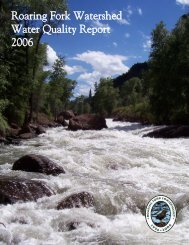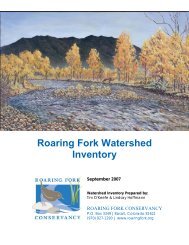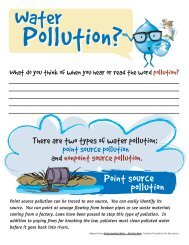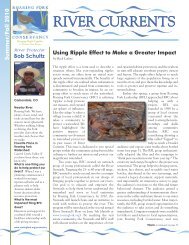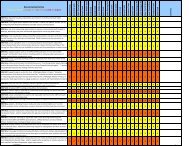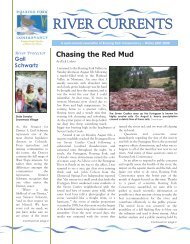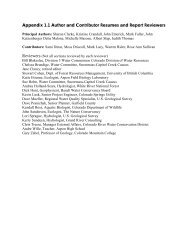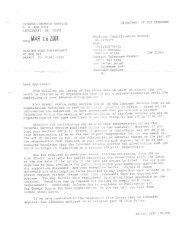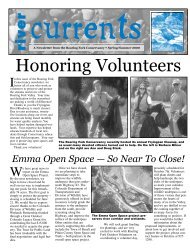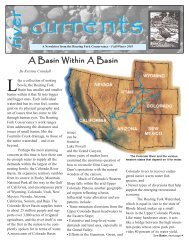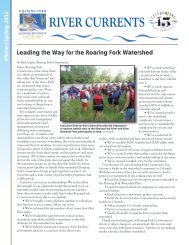New Winter 2008 Newsletter:Newsletter.qxd - Roaring Fork ...
New Winter 2008 Newsletter:Newsletter.qxd - Roaring Fork ...
New Winter 2008 Newsletter:Newsletter.qxd - Roaring Fork ...
Create successful ePaper yourself
Turn your PDF publications into a flip-book with our unique Google optimized e-Paper software.
Why <strong>Roaring</strong> <strong>Fork</strong> Watershed Plan Matters – Part I<br />
by Moss Driscoll, Legal Intern<br />
Colorado faces significant water<br />
management challenges as the state<br />
enters the 21st Century. The dramatic<br />
growth forecast for the next two<br />
decades is expected to put new<br />
pressures on the state’s alreadystrained<br />
water supplies. In response to<br />
such projections, in 2005, the General<br />
Assembly passed the Colorado Water<br />
for the 21st Century Act, establishing<br />
what is now referred to as the<br />
“Interbasin Compact Process.”<br />
The state government recognized<br />
that a new approach – one with a far<br />
greater emphasis on public<br />
involvement – was necessary to deal<br />
with the issue of future water demand.<br />
In particular, the state acknowledged<br />
the need to “provide Colorado’s water<br />
users with a means of addressing<br />
potential conflicts among<br />
themselves.” Thus, the Interbasin<br />
Compact Process is intended as a<br />
“locally-driven process where the<br />
decision-making power rests with<br />
those living in the state’s river basins.”<br />
Understanding the Interbasin<br />
Compact Process is essential to<br />
understanding the future of Colorado’s<br />
remaining unappropriated water<br />
resources. The Interbasin Compact<br />
Process incorporates nine “basin<br />
roundtables,” one for each major river<br />
basin in the state, plus one for the<br />
Denver metro area. The roundtables<br />
are comprised of members<br />
representing a wide range of local and<br />
regional interests. The General<br />
Assembly delegated three<br />
responsibilities to the roundtables:<br />
• “Develop a basin-wide consumptive<br />
and nonconsumptive water supply<br />
needs assessment;<br />
• conduct an analysis of available<br />
unappropriated waters within the<br />
basin;<br />
• propose projects or methods, for<br />
meeting consumptive and<br />
nonconsumptive needs and utilizing<br />
unappropriated waters.”<br />
To help basin roundtables obtain<br />
information for their assessments and<br />
planning, the Water Supply Reserve<br />
Account (WSRA) was created and is<br />
Welcome River Stewards!<br />
The River Stewards are a new group formed in <strong>2008</strong>.<br />
Targeting the 25-40 year old range, <strong>Roaring</strong> <strong>Fork</strong><br />
Conservancy wanted to reach out and involve a younger<br />
group of local professionals in our charge of bringing people<br />
together to protect our rivers. Our goal is to educate and<br />
empower the Stewards to help them better understand the<br />
watershed and serve as local emissaries to the Conservancy.<br />
To learn more about the River Stewards, go to<br />
www.roaringfork.org/stewards.<br />
managed by the Colorado Water<br />
Conservation Board (CWCB). From<br />
this account, the Ruedi Water and<br />
Power Authority was granted $40,000<br />
for Phase I of the watershed plan and<br />
another $40,000 for Phase II.<br />
The Interbasin Compact Process<br />
will generate data on water<br />
availability and future demand, data<br />
which will largely determine how the<br />
state develops Colorado’s remaining<br />
water resources. Thus, as the local<br />
component of the Interbasin<br />
Collaborative Process, the <strong>Roaring</strong><br />
<strong>Fork</strong> Watershed Plan represents an<br />
opportunity for interested<br />
stakeholders to help to decide how<br />
local water resources will be<br />
developed in the future.<br />
More information on “Why the<br />
<strong>Roaring</strong> <strong>Fork</strong> Watershed Plan<br />
Matters” can be found in the Phase II<br />
Guidance Document located on the<br />
<strong>Roaring</strong> <strong>Fork</strong> Conservancy website:<br />
www.roaringfork.org/watershedplan.<br />
Gruenberg Serves 9 Years<br />
as Rivers Council President<br />
After nine years of<br />
service, founding<br />
Rivers Council<br />
President Bill<br />
Gruenberg has<br />
stepped down.<br />
Thanks in large part<br />
to the dedication of<br />
Bill and his wife<br />
Joyce to the<br />
planning of our<br />
River Rendezvous<br />
celebration, the<br />
event has been a<br />
huge success each year. Bill’s commitment to the<br />
rivers and streams of the <strong>Roaring</strong> <strong>Fork</strong> Valley<br />
continues as he takes on his new role as Rivers<br />
Council Vice-President. Thank you, Bill, for all that<br />
you do in support of <strong>Roaring</strong> <strong>Fork</strong> Conservancy.<br />
7WATERSHED PLANNING




